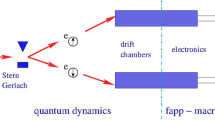Abstract
Quantum mechanics with a fundamental density matrix has been proposed and discussed recently. Moreover, it has been conjectured that the universe is not in a pure state but in a mixed state in this theory. In this paper, I argue that this mixed state conjecture has two main problems: the redundancy problem and the underdetermination problem, which are lacking in quantum mechanics with a definite initial wave function of the universe.
Similar content being viewed by others
Notes
Hartle and Hawking [7]’s no-boundary proposal can be regarded as one example of such a theory. According to this proposal, the wave function of the universe, which obeys the Wheeler-DeWitt equation, is given by a path integral over all compact Euclidean four-dimensional geometries and matter fields that have the three-dimensional geometry and matter field configuration as its only boundary. Recently, Halliwell et al. [6] gave a formulation of the no-boundary wave function directly in terms of a collection of saddle points that satisfy a specific minimal set of criteria, and argued that it determines a unique wave function. Moreover, Feleppa et al. [5] showed that the no-boundary wave function can be obtained in a simple way starting from the Friedmann-Lemaitre-Robertson-Walker line element of cosmological equations for a de Sitter universe.
Here there is a natural speculation on how to solve the puzzle of the arrow of time. It is usually thought that the past hypothesis and the statistical postulate are needed to solve this puzzle (see, e.g. [8]). It is the statistical postulate that motivated the mixed state conjecture [3]. Now it seems that QM with a definite initial universal wave function may solve the puzzle of the arrow of time in a simpler way. In this theory, the statistical postulate is dropped. Moreover, the past hypothesis can be naturally derived: since the universe has only one possible initial wave function, the initial entropy of the universe is zero, which means that the universe begins with the minimum entropy. Penrose’s [9] Weyl curvature hypothesis can be regarded as one example of such a theory.
References
Albert, D.Z.: Time and Chance. Harvard University Press, Cambridge (2000)
Chen, E. K. Quantum States of a Time-Asymmetric Universe: Wave Function, Density Matrix, and Empirical Equivalence. http://philsci-archive.pitt.edu/15658/ (2019)
Chen, E.K.: Quantum mechanics in a time-asymmetric universe: on the nature of the initial quantum state. Br. J. Philos. Sci. 72(4), 1155–1183 (2021)
Dürr, D., Goldstein, S., Tumulka, R., Zanghi, N.: On the role of density matrices in Bohmian mechanics. Found. Phys. 35(3), 449–467 (2005)
Feleppa, F., Licata, I., Corda, C.: Hartle-Hawking boundary conditions as Nucleation by de Sitter Vacuum. Phys. Dark Universe 26, 100381 (2019)
Halliwell, J.J., Hartle, J.B., Hertog, T.: What is the no-boundary wave function of the Universe? Phys. Rev. D 99, 043526 (2019)
Hartle, J.B., Hawking, S.W.: Wave function of the Universe. Phys. Rev. D 28, 2960 (1983)
Loewer, B.: The Mentaculus vision. In: Allori, V. (ed.) Statistical Mechanics and Scientific Explanation: Determinism, Indeterminism and Laws of Nature, pp. 3–30. World Scientific, Singapore (2020)
Penrose, R.: On the second law of thermodynamics. J. Stat. Phys. 77, 217 (1994)
Acknowledgements
I wish to thank Eddy Keming Chen, Shelly Goldstein, Tim Maudlin and Rodi Tumulka for helpful discussion.
Author information
Authors and Affiliations
Contributions
I am the sole author.
Corresponding author
Ethics declarations
Competing interest
The authors declare no competing interests.
Additional information
Publisher's Note
Springer Nature remains neutral with regard to jurisdictional claims in published maps and institutional affiliations.
Rights and permissions
Springer Nature or its licensor (e.g. a society or other partner) holds exclusive rights to this article under a publishing agreement with the author(s) or other rightsholder(s); author self-archiving of the accepted manuscript version of this article is solely governed by the terms of such publishing agreement and applicable law.
About this article
Cite this article
Gao, S. Is the Universe in a Mixed State?. Found Phys 54, 7 (2024). https://doi.org/10.1007/s10701-023-00742-6
Received:
Accepted:
Published:
DOI: https://doi.org/10.1007/s10701-023-00742-6




